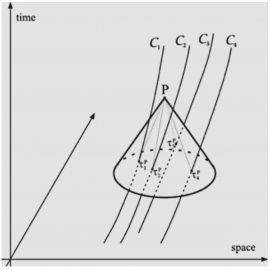
Feasibility study of a space-based relativistic PNT system
DESCRIPTION
All GNSS in operation at present are based on Newtonian physics and rely on global reference frames fixed to Earth. Relativistic effects are treated as deviations that need to be corrected for. Precision and stability over time of the reference frames is provided via ground stations and they are limited by the Earth’s dynamics (e.g. variations of the Earth’s rotation rate, plate tectonics, tidal crustal effects) and atmosphere.
An RPS (Relativistic PNT System) would consist of a constellation of satellites, with each one broadcasting not only its proper time at emission but also the proper times that it receives from the other satellites. It would inherently establish a local reference frame based only on the dynamics of the satellites and, as a consequence, would be completely independent of a terrestrial frame. This local reference frame would be the Autonomous Basis of Coordinates (ABC) system that requires no time synchronisation. At each space-time event (user location) reached by the signals, the received times (at least four) would enable the emission coordinates of this event to be defined with respect to the ABC. In order to use the system on the Earth surface, a limited ground segment network would be required to define the transformation of the ABC system with the currently used inertial and terrestrial time coordinate reference systems.
The main advantages of RPSs is that they naturally incorporate general relativity, are independent of any terrestrial frame and provide an independent, robust and self-consistent navigation solution, with potentially higher performance. Potential benefits of using these systems would be more accurate and robust positioning solutions for standard applications and a new framework for new scientific applications. A sub-millimetre level of accuracy of satellite positions would have major impacts in different fields. In astronomy, space physics and Earth sciences, increased precision of space and time localisation of events is associated with better knowledge of the phenomena studied. Thus, for example, the following advances could be possible:
- Geophysics: Earth shape, continental drift and tides would be measured with unprecedented precision to model Earth crust stress, leading to reliable earthquake prediction;
- Fundamental physics: accurate measurements of the space-time curvature around the Earth could lead to the detection of gravitational waves and the measurement of other physical phenomena;
- Metrology: RPS could be used itself as an independent clock with long-term stability;
- Space exploration: remarkable advances would be possible in orbit determination and space navigation; as a universal, independent and autonomous positioning system, RPS would be possible anywhere in the Solar System.
Theoretical formulations of such a system have been proposed in literature (Coll 2006, Delva 2011, Saez 2014, Kostic 2015) considering that a satellite broadcasts not only its proper time at emission but also the proper times that it receives from the other satellites (via cross-satellite links). However, none of the proposed approaches were intended to be practical. Going from those to systems that can actually be deployed would entail further developments in the required numerical tools and technology. The expected advantages are presumed to be significant; however, the main practical feasibility challenges of such a system still need to be assessed.
The objective of this activity is to analyse the advantages of Relativistic Positioning Systems (RPS) for specific timing and positioning applications.
This analysis aims at performing high-level system analysis, including key trade-offs, and addressing the main practical feasibility/implementation challenges of a global space-based relativistic PNT system (onboard hardware, such as atomic clocks, cross-links, and ground based infrastructure) taking into consideration current and near-future available state-of-the-art technology.
The activity will initially assess two use-cases less affected by the terrestrial frame:
- the realisation of system time in space, and its dissemination to users, without the need for ground synchronisation;
- the positioning of space-based users who do not necessarily need to be linked to a terrestrial reference frame.
The tasks to be performed will include:
- study of the RPS state-of-the-art and theoretical basis, and assessment of its benefits;
- definition of a suitable relativistic autonomous time-space reference system (ABC) based on RPS and its connection with the currently used inertial and terrestrial time and coordinate reference systems (UTC, ICRF and ITRF);
- preliminary high-level system design and assessment of practical implementation aspects;
- analysis of RPS application for the selected use-cases.
The results of the activity will provide:
- RPS maturity and feasibility assessment for PNT applications;
- requirements for an RPS satellite proof of concept based on current and near-future available state-of-the-art technology.
esa-STAR link: http://emits.sso.esa.int/emits/owa/emits.main
